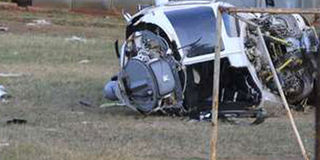Bosses of firm that sold doomed aircraft languish in prison

The wreckage of the helicopter that crash-landed at the National Youth Service engineering institute, near Mathare, on September 8, 2016. After the first test at the airport, there was a warning that the Automatic Flight Control Unit was not functioning normally. PHOTO | WILLIAM OERI | NATION MEDIA GROUP
What you need to know:
- Questions on why a five-month-old helicopter dropped from the sky are likely to feature prominently during investigations.
- Seventy-year-old Finmeccanica chief executive Giuseppe Orsi is serving a four-and-a-half-year term while his deputy and former head of AugustaWestland Bruno Spagnolini is in for four years.
Executives of the firm that sold Kenyan police aircraft that crashed in Nairobi are in Italian jails over a scandal involving helicopter sales to India.
The Nairobi crash and the corruption investigations going on in India will add pressure on the company and put the spotlight on the procurement of the chopper by the Kenya Police Service.
Questions on why a five-month-old helicopter dropped from the sky are likely to feature prominently during investigations.
The National Police Airwing said on Wednesday that the chopper flew for only 24 hours before going down.
The aircraft was fitted with special features such as night vision, a full medical evacuation kit and security cameras.
Questions have been raised on whether the country got value for its money, following the purchase of the doomed aircraft from AugustaWestland, an Italian company that has changed its name to Leonardo to rescue its reputation.
Caprarella Roberto, a Leonardo official, told the Nation that the helicopter was brand-new.
“We confirm that the AgustaWestland AW139 supplied to Kenya was a new helicopter,” said the media relations officer of Leonardo.
The company’s two senior officials are in jail for corruption and falsifying records while selling choppers to India.
Seventy-year-old Finmeccanica chief executive Giuseppe Orsi is serving a four-and-a-half-year term while his deputy and former head of AugustaWestland Bruno Spagnolini is in for four years.
The trial concerned bribes in a $638 million contract awarded to the Finmeccanica unit of AugustaWestland in 2010 to supply 12 helicopters to India.
Two years ago, India cancelled the contract and the matter is under arbitration.
Detectives from the Air Accident Investigation Division (AAID) of Kenya on Thursday visited the crash site and interviewed witnesses.
They also mapped and picked evidence from the site with the aim of constructing a picture of the chopper’s last moments, after interviewing the pilots.
“We have been informed that Interior Cabinet Secretary Joseph Nkaissery will form a commission to investigate the accident,” Martyne Lunani, the head of AAID told the Nation.
PROBING CAUSE OF CRASH
Investigators have hinted that they would be keen to know if the helicopter had technical problems.
Questions have been raised previously on whether the country bought a new or second hand chopper, with experts raising doubts of a new aircraft crashing in the circumstances under which the AW139 went down.
Two years ago, a similar new AW139 killed British millionaire Lord Ballyedmond at a time he had sued AgustaWestland for selling him a faulty aircraft.
He was seeking a refund of the £10.7 million purchase price of the helicopter.
The Telegraph reported that papers lodged in court said “the aircraft suffered from a number of defects and reliability problems, including there being a big hole in one of its blades, oil leaks from the main gearbox, unexplained vibrations and failures of the internal entertainment, communication, lighting heating and electronic maps and full ice protection systems”.
Lord Ballyedmond was one of the richest men in Northern Ireland with an estimated fortune of £500 million.
Reports say an AgustaWestland engineer was aboard the Kenyan aircraft when it crashed.
The chopper was bought for Sh683 million in the 2014/15 financial year.
When it was launched, Mr Nkaissery praised it as one of the best in the market and that it was capable of flying for 1,000 kilometres without refuelling.
Reported by John Kamau, Zadock Angira and Nyambega Gisesa




